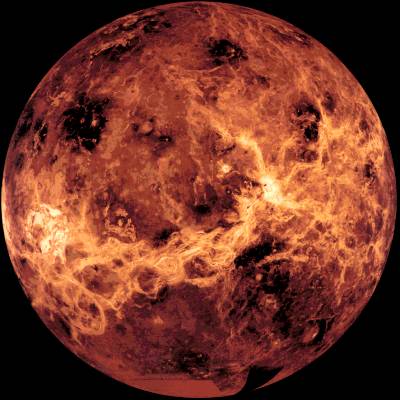Venus
![]()
Venus is very similar in size to the Earth, and a little closer to the Sun, but it has taken a vastly different course of evolution, both in terms of its atmosphere and internal processes. The image below was taken by NASA's Pioneer Venus probe as it approached Venus in December 1978.

[ NASA / JPL / Caltech ]
| Siderial Period |
Perihelion (AU) |
Aphelion (AU) |
Inclination (degrees) |
Axial Tilt (deg) |
Axial Period (d, h, m) |
|---|---|---|---|---|---|
| 224.70 d | 0.72 | 0.73 | 3.4 | 177.3 | 243, 0, 14.4, R |
| Equatorial Diameter (km) |
Oblateness | Mass (Earth = 1) |
Density (water = 1) |
Albedo (geom.) |
No. of Satellites |
| 12, 104 | 0.000 | 0.82 | 5.2 | 0.65 | 0 |
Atmosphere
It is believed that Venus once possessed, like the Earth, huge oceans of water early in its history. However, as the Sun emits approximately 10% more radiation every billion years it is likely that after a short time the oceans began to evaporate, leading to a run-away greenhouse effect. Water is a far more effective greenhouse gas than carbon dioxide (CO2), and soon Venus's oceans of water had completely evaporated into an already extremely dense CO2 atmosphere. The water vapour then combined with various volcanic gases already present in the atmosphere, such as sulphur dioxide (SO2), to form thick clouds of sulphuric acid.
Internal processes
Since the Magellan mission to Venus, which radar-mapped the surface in unprecedented detail, the mystery surrounding Venus' internal mechanism has only deepened. Since the discovery of a completely uniform distribution of impact craters across the entire surface, planetary geologists have been unable to satisfactorily explain how Venus works. Even the smallest, coldest satellites of the giant planets appear to have regions of terrain of varying ages, but Venus' surface appears to be all one age. This is highly unusual.
Missions to Venus
For a list of missions to Venus see the links page.

The image above shows the surface of Venus, and was produced following the
magnificent NASA radar-mapping mission Magellan.
[ NASA / JPL / Caltech ]